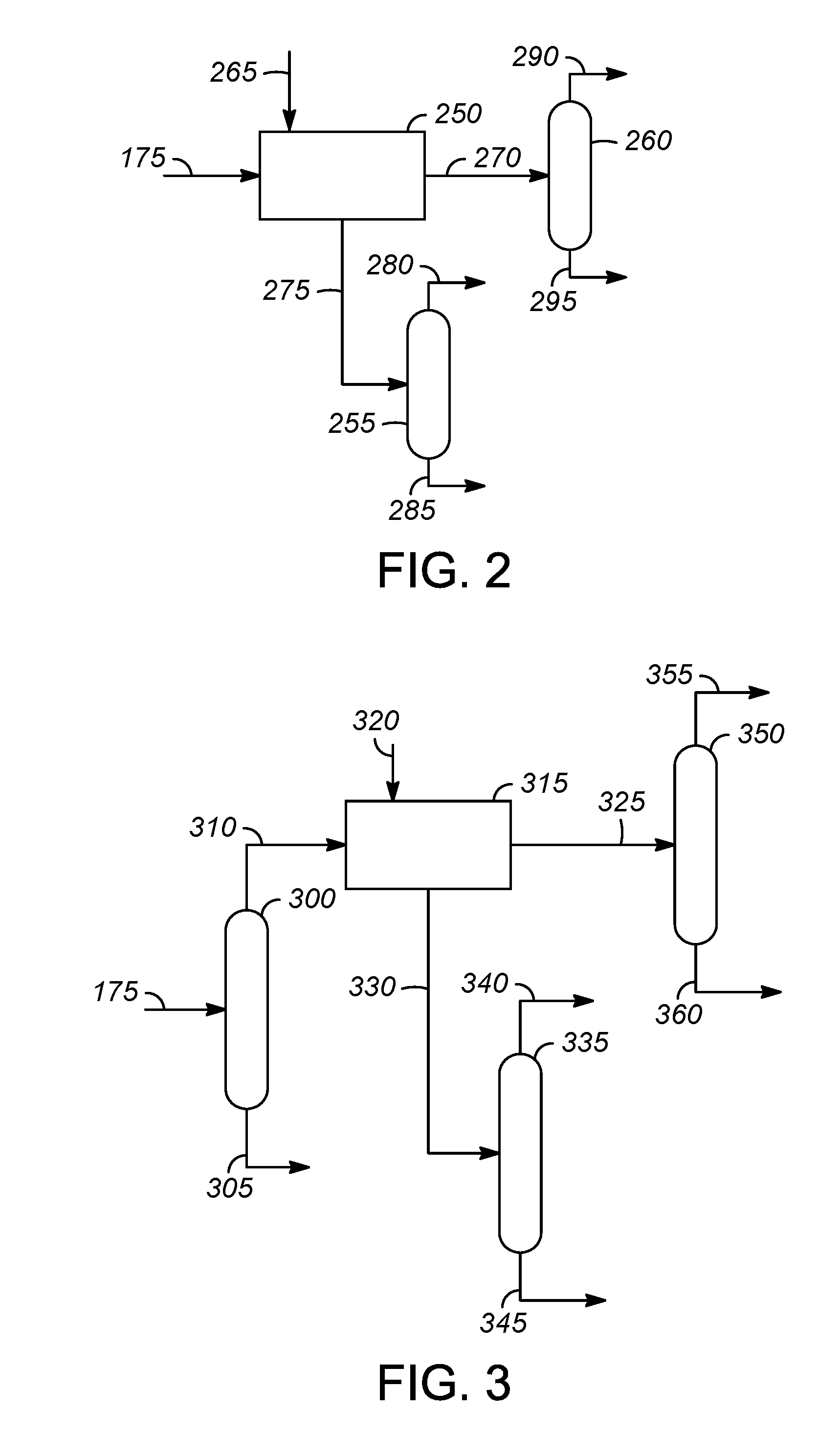Processes for producing polymer grade light olefins from mixed alcohols
a technology of mixed alcohols and light olefins, which is applied in the direction of hydrocarbon by metathesis reaction, hydrocarbon preparation catalysts, ether preparations, etc., can solve the problems of less desirable petroleum-based feedstocks and achieve the effect of high purity
- Summary
- Abstract
- Description
- Claims
- Application Information
AI Technical Summary
Benefits of technology
Problems solved by technology
Method used
Image
Examples
example 1
[0055]A mixed alcohol feed having the feed composition in Table 1 was dehydrated into olefins over an amorphous silica-alumina catalyst. The dehydration was completed at a reactor temperature of about 340.6° C. (645° F.), at a reactor pressure of about 1965 kPa(g) (285 psig), and a weight-hourly-space velocity of about 5.0 hr−1. The resulting non-water product distribution is shown in Table 2. The data shows that significant amounts of oxygenates and unconverted alcohols remained in the non-water reactor effluent after dehydration. Operation at higher conversion and proper removal of trace oxygenates would have reduced these byproducts to more manageable levels, in which case, the product would be suitable feed to the olefins separation process described herein.
TABLE 1Mixed Alcohol Feed Compositions2-Propanolmass % 0.31-Butanolmass % 4.81-Propanolmass %26.92-Methyl-1-butanolmass % 5.21-Pentanolmass % 6.31-Hexanolmass % 4.52-Butanolmass % 1.62-Ethyl-1-hexanolmass % 1.01-Heptanolmass ...
example 2
[0056]A mixed alcohol feed having the feed composition shown in Table 3 was dehydrated into olefins over a gamma-alumina catalyst. The dehydration was completed at a reactor temperature of 337.8° C. (640° F.), at a reactor pressure of about 1034 kPa (g) (150 psig), and a weight-hourly-space velocity of about 1.0 hr−1. The resulting non-water product distribution is shown in Table 4. In contrast to the reactor effluent produced with the catalyst in Example 1, the oxygenates and unconverted alcohols in this example were reduced to very low levels in the non-water reactor effluent, which simplifies the oxygenates removal process prior to light olefins separation. The reactor effluent produced with gamma alumina, once treated for oxygenates, would be suitable feed to the olefins separation process disclosed herein.
TABLE 3Mixed Alcohol Feed Compositions2-PropanolMASS-PCT 1.21-ButanolMASS-PCT 0.11-PropanolMASS-PCT18.12-Ethyl-1-hexanolMASS-PCT 0.72-methyl-1-propanolMASS-PCT79.9
TABLE 4Gamma...
specific embodiments
[0060]While the following is described in conjunction with specific embodiments, it will be understood that this description is intended to illustrate and not limit the scope of the preceding description and the appended claims.
[0061]A first embodiment of the invention is a process for providing a high purity olefin product, the process comprising dehydrating a feedstream comprising a mixture of alcohols having 3 to 8 carbon atoms and forming a mixed olefin stream and a water stream, the mixed olefin stream comprising a mixture of olefins having 3 to 8 carbon atoms, separating the mixed olefin stream into at least a C3 olefin stream comprising olefins having 3 carbon atoms and a C4-8 olefin stream comprising olefins having 4 to 8 carbon atoms, separating the C4-8 olefin stream into a C4 olefin stream comprising olefins having 4 carbon atoms and a C5-8 olefin stream comprising olefins having 5 to 8 carbon atoms; and purifying at least one of the C3 olefin stream and the C4 olefin str...
PUM
| Property | Measurement | Unit |
|---|---|---|
| temperature | aaaaa | aaaaa |
| temperature | aaaaa | aaaaa |
| pressure | aaaaa | aaaaa |
Abstract
Description
Claims
Application Information
 Login to View More
Login to View More - R&D
- Intellectual Property
- Life Sciences
- Materials
- Tech Scout
- Unparalleled Data Quality
- Higher Quality Content
- 60% Fewer Hallucinations
Browse by: Latest US Patents, China's latest patents, Technical Efficacy Thesaurus, Application Domain, Technology Topic, Popular Technical Reports.
© 2025 PatSnap. All rights reserved.Legal|Privacy policy|Modern Slavery Act Transparency Statement|Sitemap|About US| Contact US: help@patsnap.com



